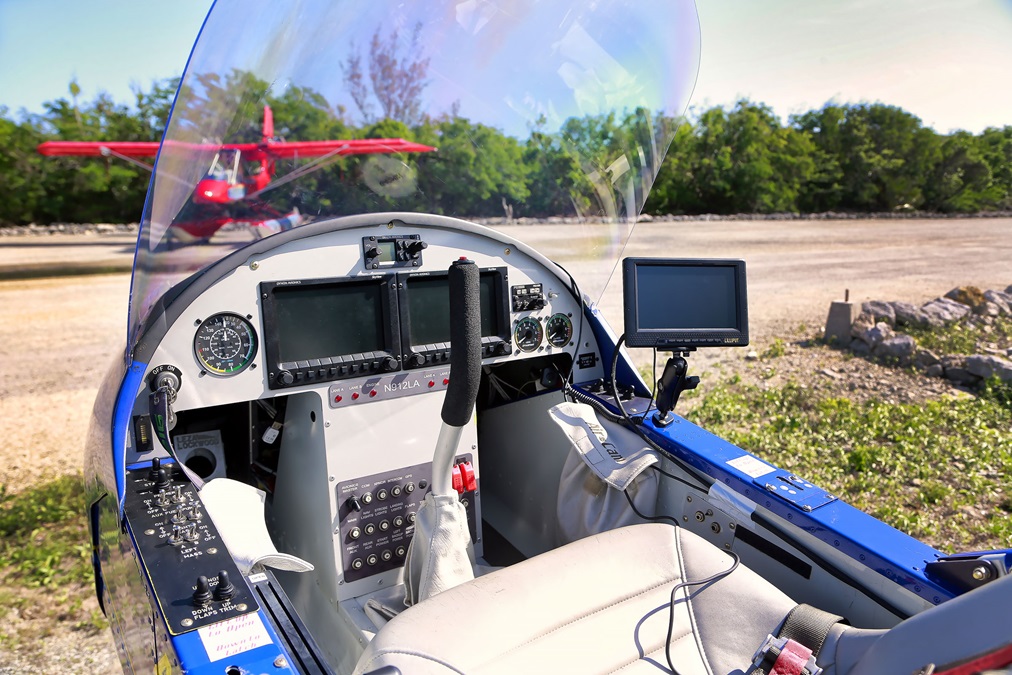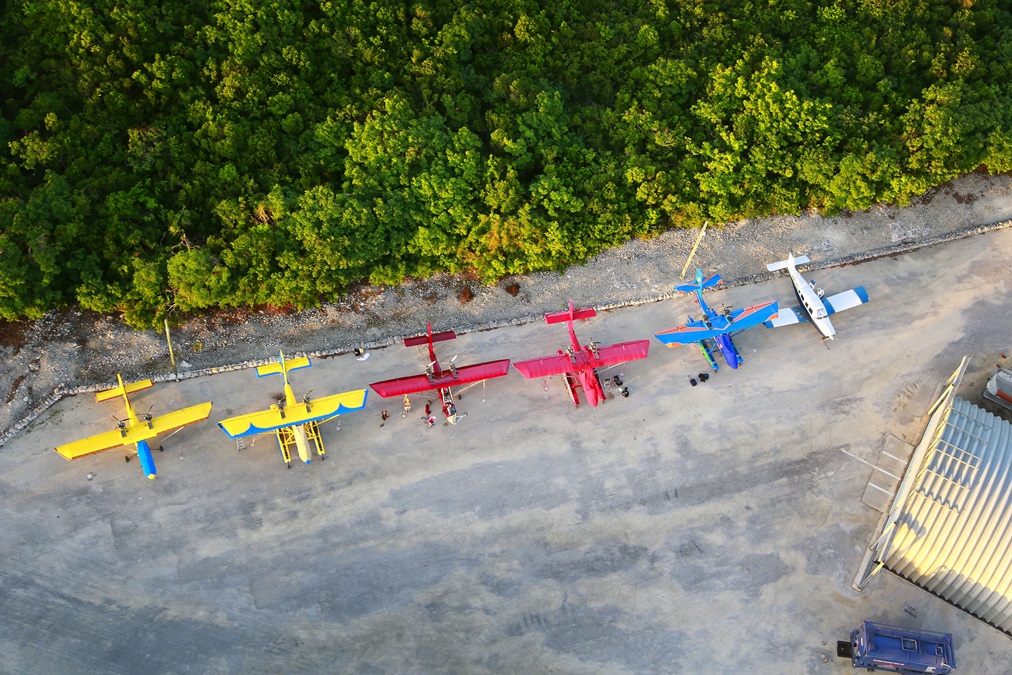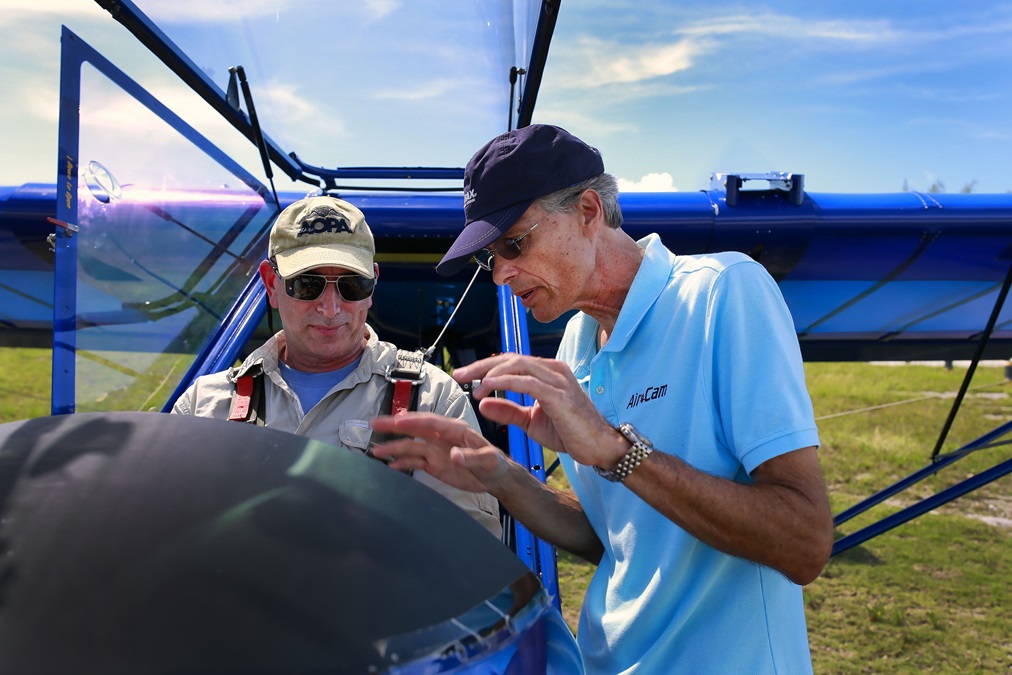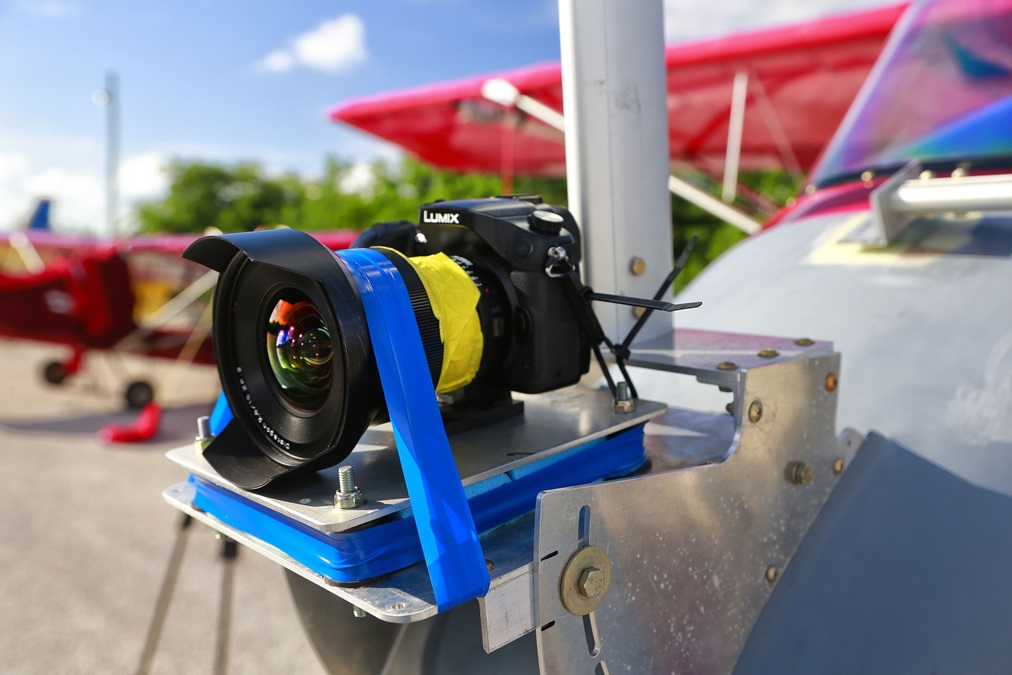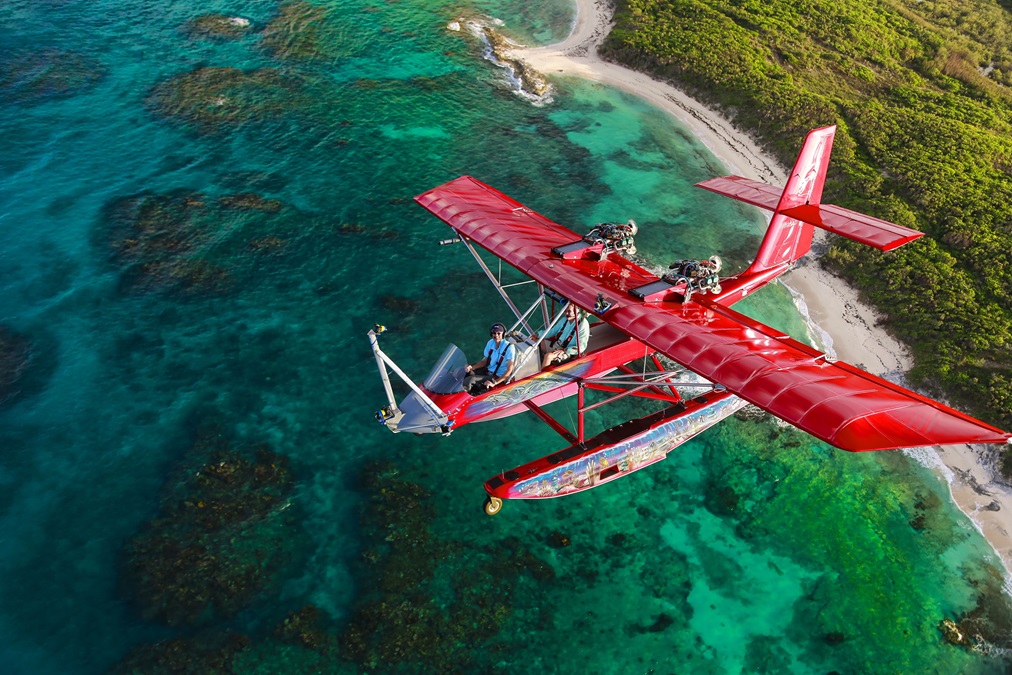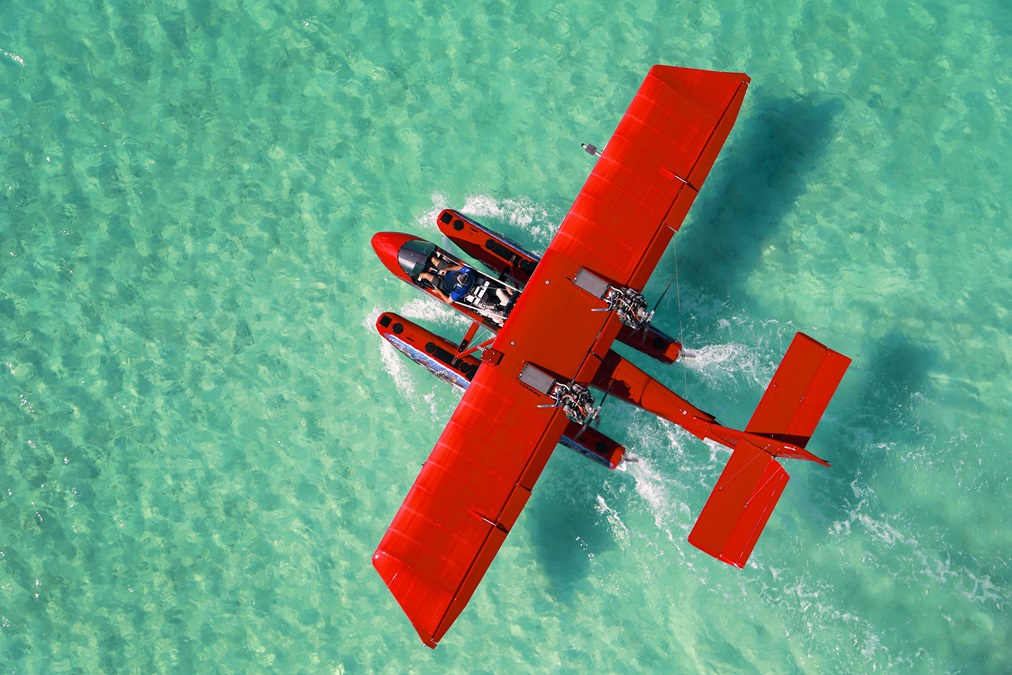Standing by a gigantic, 49-inch video screen, the normally placid and soft-spoken Phil Lockwood is uncharacteristically animated—and not in a happy way.
“The Jell-O in this image is obvious 10 feet away,” he says disgustedly. “None of this video is even close to usable. There’s way too much vibration in the camera. Totally unacceptable.”
Tall and stick-figure thin, Lockwood paces the room, gesturing with his hands and arms.
The first of the AirCam crew’s nightly video review sessions is taking place at idyllic Stella Maris Resort in the Bahamas. A half-dozen AirCam owners, as well as company employees, have flown 310 nautical miles here from South Florida, bringing a half-dozen twin-engine, two-seat aircraft that were originally designed as aerial camera platforms. Their annual get-together also serves as a chance to collect video for the stunning visual feasts AirCam puts out each year to promote its products.
Images of AirCams flying by waterfalls in Costa Rica, skimming the Everglades, and splashing down in the translucent Bahamian waters have been seen hundreds of thousands of times on YouTube and Vimeo and shared around the world via social media. Lockwood is convinced the breathtaking scenes are central to the company’s success. He devotes a great deal of the company’s effort and resources to presenting the best possible video images, and this first day of filming has proved deeply frustrating as three of the four state-of-the-art 4K ultra-high-definition camera systems used on the most recent flight have produced useless images.
“You might as well clear those [data] cards,” Lockwood says. “There’s nothing worth seeing on them.”
The AirCam crew manually focuses their cameras before flying and sets the lenses in place with tape so the focus can’t change. Perhaps the blurry images are the result of the lenses being out of focus from the start.
Brad Fuller, a principal at Florida Film and Tape and an AirCam video consultant, isn’t convinced.
“I think the focus is just fine,” he says. “The blurriness we’re seeing is the result of a shutter-speed problem.”
Fuller speeds up the shutter speed on all three errant cameras and says he’s certain the results will be better the next day.
Flying and photography
Lockwood’s aviation and photographic roots are deeply intertwined. He was an avid amateur photographer during college at the Florida Institute of Technology. In the 1980s, he flew extensively with Emmy-winning wildlife photographers Desmond and Jennifer Bartlett, and he traveled with them to Africa to film Survivors of the Skeleton Coast, a pioneering documentary that showed the migration of elephants in Namibia from the air. In the late 1990s, National Geographic’s Michael Nichols commissioned Lockwood to build the first AirCam for filming over the dense and largely inaccessible Ndoki rain forests in central Africa’s Republic of the Congo.
Lockwood, who by that time had years of experience designing and flying ultralights, insisted a twin-engine airplane capable of taking off from a standing start on one engine was the best way to reduce risks in that region to a tolerable level.
Lockwood was so impressed by the prototype AirCam in Africa that he built one for himself when he returned home to Florida, and it became a sensation. Today, more than 200 kitbuilt AirCams have been registered and flown. And videos have become a staple of AirCam’s marketing and sales efforts.
“There’s no question we devote a great deal of resources to video for a company of our size,” Lockwood said. “But I’m sure it’s well worth the effort. For me, it’s also fun. I’ve been passionate about photography for almost as long as I’ve been involved in aviation.”
The company’s self-produced videos are inspiring, glorious reflections meant to convey the essential experience of flying an aircraft with almost limitless visibility through some of the world’s most sublime landscapes.
“Video is the best way we’ve found to give people a real sense of what flying an AirCam is all about,” said Lockwood, whose AirCam combines the words air and camera. “We’ve found that those who are intrigued by the things they see in our videos and follow up with demo flights in our airplanes absolutely love the experience, and they become AirCam customers.
“Video production is a key to our marketing efforts, and our company’s success,” he said. “If our videos also happen to inspire people to fly other aircraft and are good for aviation, well, that’s good, too.”
AOPA Pilot came along on this year’s AirCam gathering for a behind-the-scenes look at how Lockwood and his team consistently get such amazing results. The part you won’t see in the videos is that everyone involved subjected themselves to swarms of mosquitoes, biting flies, blistering sun, and a hurricane warning. The crew worked long hours, often editing images and preparing photo gear late into the night.
“People ask us how we get such great imagery, and a big part of the answer is that we just try really hard,” Lockwood said. “We’re willing to make ourselves uncomfortable to get the results that we’re after.”
Preparing the studio
Setting up an AirCam for a video flight can take hours. Each airplane is fitted with up to five cameras, each one capable of collecting 200 gigabytes or more of data on a single hour-long flight. In addition to the 4K cameras, they use GoPros extensively. Even these relatively simple devices are placed in specialized, foam-padded boxes the crew has designed to reduce vibration and eliminate the possibility of condensation fogging their protective housings.
The AirCam team also developed a series of specialized mounts for placing their cameras at the optimum viewing angles.
Multiple cameras turn an AirCam into a flying video studio. High-definition cameras look forward, aft, and sideways, and they record the expressions on the occupants’ faces, along with incredibly sharp pictures of the outside world. The cockpit is even equipped with a video monitor so the pilot can frame the shot by maneuvering the airplane—not adjusting the camera.
Lockwood and his team design and fabricate all their own camera mounts and vibration dampeners, and they do all their own flying when recording AirCams over scenic locations.
“I’m good at designing, engineering, and building—and our team is very good at collecting high-quality video,” Lockwood said. “We try to get results that are similar to a helicopter flying with a $100,000 gyrostabilization system—but obviously we’ve got to do it at a fraction of the cost. Our limited budget requires us to be creative and resourceful.”
AirCam staffer Justin Smith and Ian Lockwood, the AirCam founder’s son and a drone expert, spend hours before each flight making sure the cameras are rigged just right. In addition to anchoring each camera to its mount with at least one quarter-inch screw, they also use copious amounts of gaffer tape and cable ties as “cheap insurance.”
AirCams fly slowly, typically about 65 knots or less on video flights, but the air loads on the bulky camera gear can be significant.
“We’ve never had a camera come off in flight,” said Smith, 21, who has worked at AirCam since he started sweeping floors there in high school. “One of my jobs is to keep it that way.”
No Jell-O!
As painstaking as the camera set-up process is, the actual photo flights themselves are loosely organized. On one three-ship flight, Lockwood flew the main camera airplane with AOPA Photographer Chris Rose in the front seat. An amphibious red AirCam was the main photo subject and flew the lead position. David Lewis, an AirCam builder from central Tennessee, flew the number-three aircraft with AOPA videographer Josh Cochran.
They flew over the north end of Long Island, less than 10 miles from their starting point at Stella Maris, and there was plenty of improvisation as the group spotted interesting backdrops and targets of opportunity along the way.
Lockwood put Rose and his camera exactly where he wanted to be—and Lockwood’s photographic knowledge helped him to anticipate the optimum light angles.
“Understanding both flying and photography gives me a good idea what the photographer is trying to accomplish,” he said. “Formation flying skills allow me to put him as close as he needs to get.”
The float AirCam touched down in a shallow lagoon with Lockwood alongside while Lewis maneuvered in trail, giving Cochran an overview of the colorful scene.
Rose asked for a head-on pass of the float AirCam on the water, and Lockwood provided it twice, producing dramatic still images.
With ideal weather conditions, we arranged another photo flight in the late afternoon. This time Lockwood chased a Cessna 182 over the same locations, as well as through a few trips around the pattern at the airport. Even though the AirCam and 182 are quite dissimilar, there was enough overlap in their flight envelopes to allow them to fly together.
The two aircraft overflew the rocky coves and white-sand beaches at the north end of the island, where there’s a monument to Christopher Columbus—who is reputed to have landed here on his history-shaping first voyage to the New World in 1492. The airplanes circled left and right about 400 feet over the water, which seemed low in a 182, but not the AirCam. Lockwood and Rose were wearing vented long-sleeved shirts, and the rush of air at 65 knots made their shirts billow out comically.
The airplanes touched down a few minutes before sunset, shut down, and the occupants were descended upon by clouds of swarming mosquitos, along with less visible but equally bloodthirsty sand flies.
Someone suggested bolting, but Lockwood dismissed that idea out of hand. All the cameras had to be collected right away, recharged overnight, and the video images carefully evaluated so that technical improvements could be made and any problems corrected.
That night, we all awaited the moment of truth around the video monitor. This time, the images from all the cameras—the Panasonic Lumix GH4 with a 7-to-14 millimeter Zeiss lens; a Canon 5D Mark II with a 14-mm lens, and a Sony A7RII with a full-frame sensor and 15-mm lens—were flawless.
There were no image-wrecking smashed insects on the lenses, and as Fuller predicted, changing the shutter speed—not the focus—made the images razor sharp.
“No Jell-O!” Lockwood exulted. “Let’s not lose any of this data. Back up all of these cards right away. We brought lots of cards for just this purpose. This is exactly what we came for.”AOPA
Email [email protected]

